Today, we will delve into the fascinating world of Channel Setting, a technique that is beloved and well-known among diamond and jewelry enthusiasts.
If you desire a timeless piece of jewelry that combines durability with aesthetic appeal, then a channel-set design is definitely worth considering.
To help you fully understand the intricacies of channel settings, we will explore various aspects including: What exactly is a Channel Set Engagement Ring, the advantages and disadvantages of channel settings compared to other options, and much more.
Join us as we unravel the mysteries of Channel Settings and provide you with a comprehensive knowledge of this captivating technique.
DESIGN YOUR OWN ENGAGEMENT RING: START WITH A SETTING OR START WITH A DIAMOND. IT’S REALLY UP TO YOU!
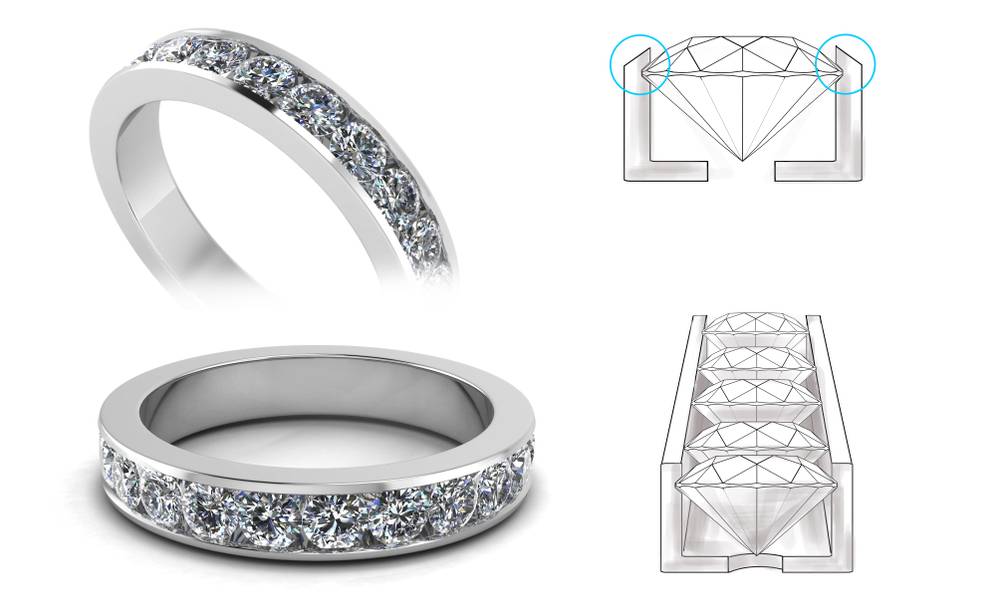
What Is A Channel Set Engagement Ring?
A channel set ring is an engagement ring style where small diamonds (or other gemstones) are placed within a precisely carved channel. These diamonds are typically protected by a thin lip that slightly extends over their edges. Some channel set rings also incorporate grooves within the channel to securely hold the stones in place.
In terms of construction, a channel setting is similar to a pavé setting, as the diamonds are held in position by thicker metal. This setting is smooth and snag-free, as there are no prongs securing the stones.
To summarize, a channel setting features gemstones arranged in a channel created by two metal strips, forming a row that can run along the band of the ring. It provides a secure method of embedding small diamonds, resulting in a flush and sparkling row. The diamonds are tightly spaced within the grooves of the channel.
It’s important to note that a channel setting may not be the sole setting in a ring’s design. For instance, the central diamond might be set using prongs or a bezel, with the channel setting reserved for the ring or halo.
Channels can be fully or partially set, but if the bars are fully set, there is often a gap at the bottom of the band to protect the diamonds from wear. This effect is reminiscent of eternity rings, with the distinction that a channel-set ring usually includes a central stone in its setting.
When it comes to channel settings, the most commonly used diamond shape is the brilliant round cut, which gives the metal strips a triangular appearance. Smaller diamonds create an exquisite and traditional look, while larger diamonds provide a contemporary and striking appearance. The princess cut diamonds are the second most popular choice for channel settings, as their square shape allows for a seamless and continuous row of diamonds without any gaps.
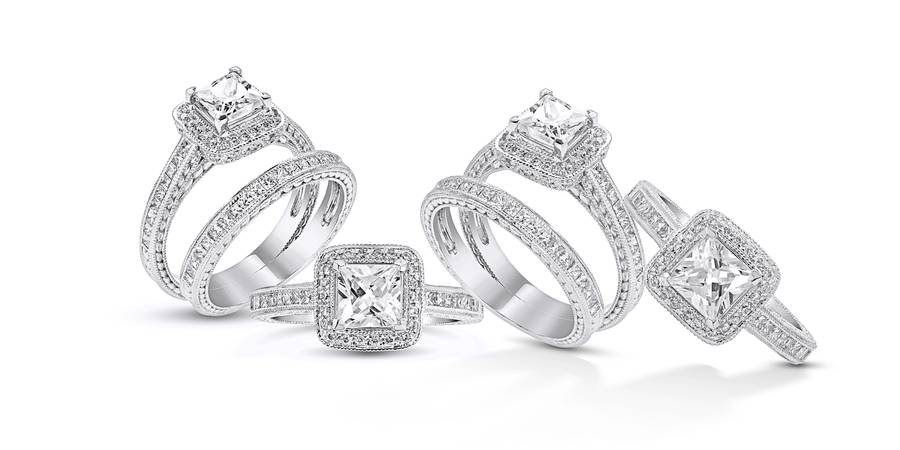
Channel Settings vs. Other Options
Let’s explore the key distinctions between channel settings and other popular settings!
Pavé vs. Channel Settings
In pavé settings, diamonds cover a larger portion of the surface, minimizing the visibility of metal. On the other hand, in channel settings, diamonds are placed within a carved channel, with a small lip at the top securely holding them in place. The metal in channel settings is more prominent and partially obscures the diamonds.
The Choice of Diamond Shape
Pavé settings commonly use small round diamonds as their shape is ideal for maximizing coverage on the ring’s surface. In channel settings, various diamond shapes can be used. While round cut diamonds are popular, princess cut, emerald cut, and cushion cut diamonds are also frequently employed.
The Purpose of the Setting
In channel settings, diamonds are positioned within the ring, drawing attention to the central diamond and serving as a complement rather than the main focus. Conversely, pavé settings often aim to enhance the overall brilliance of the ring and bring more sparkle to a center stone with lower brightness.
Prong vs. Channel Settings
Diamonds and gemstones sparkle more in prong settings as light can enter and reflect from all angles. In contrast, channel settings do not expose the diamonds as much, resulting in reduced brilliance. However, channel settings are more durable and secure. They are a suitable choice if you prefer to avoid snagging on clothing or hair.
Bezel vs. Channel Settings
Both bezel and channel settings are snag-free and highly secure settings for diamonds and colored stones. Channel settings are commonly used to accentuate the ring’s shank and adorn wedding rings. Unlike bezel settings that use separate bezel frames to enclose each gem, channel settings create a continuous and linear design.
Bar vs. Channel Settings
Although channel and bar settings may appear similar, they have differences. Channel settings enclose the diamonds on all sides, while bar settings expose the gems on two sides. The vertical metal walls in bar settings allow for increased brightness and light reflection. On the other hand, channel settings provide a more stable method of keeping small diamonds and stones securely on the band.
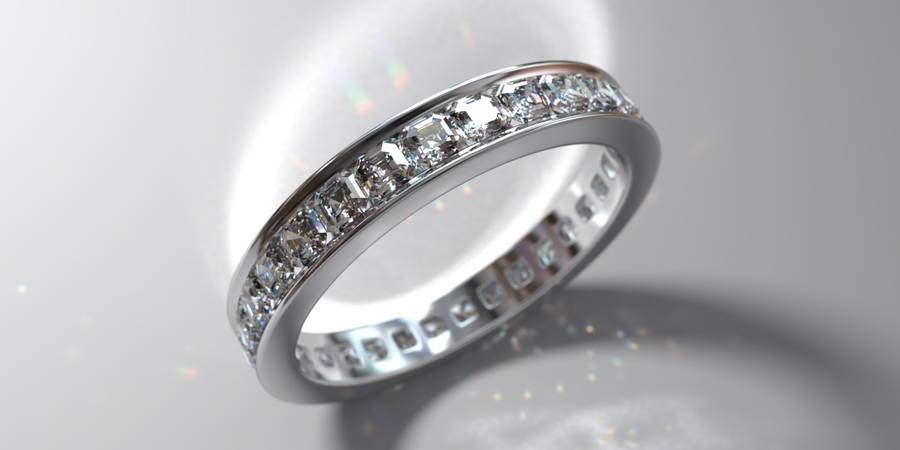
Pros of Diamond Setting Rings
Like any ring setting, channel set rings come with their own set of advantages. Let’s explore the benefits in detail:
- Enhanced Diamond Protection:
Channel settings offer excellent protection for diamonds. By placing the diamonds within the channel, they are less prone to impacts and bumps. The surrounding metal acts as a protective barrier, keeping the diamonds securely in place. The slight elevation of the metal above the diamonds also minimizes direct contact, reducing the risk of damage. - Increased Sparkle:
Channel settings can provide additional sparkle to the ring. The presence of multiple diamonds within the channel creates a radiant effect. This allows for a dazzling piece of jewelry without relying solely on a large center stone. The smaller channel-set diamonds can be chosen with excellent cuts and colorless appearances, offering impressive brilliance at a more affordable price. - Ideal for Wedding Rings:
Channel settings are popular choices for wedding rings, adding a touch of elegance and sophistication. Whether you opt for a full channel setting or partial channel accents, it adds a luxurious element to your wedding band. The versatility of channel settings allows them to be stacked alongside other ring styles, such as prong settings, creating a unique and personalized wedding set. - Versatility:
Channel settings complement various diamond shapes, especially square forms like princess-cut diamonds and baguettes. When placed in a channel, square diamonds create a seamless and continuous row of brilliance. Round diamonds, on the other hand, give the illusion of floating within the channel. This versatility makes channel settings suitable for anniversary rings, wedding bands, eternity rings, and tennis bracelets.
In conclusion, channel settings offer diamond protection, enhance the overall sparkle of the ring, are ideal for wedding bands, and provide design flexibility with different diamond shapes.

Cons of Diamond Settings
While channel settings offer numerous benefits, it’s important to consider a few drawbacks before making your purchase.
- Cleaning Challenges:
Channel settings often require more frequent cleaning compared to other setting styles. Debris can accumulate between the diamonds, diminishing their brilliance over time. Regular cleaning is necessary to maintain their sparkle. While jewelers can easily polish this design, it’s important to keep up with cleaning to prevent buildup. Professional cleaning once a year is recommended, but you can also clean your ring at home with simple maintenance.
Now, let’s delve into some of the cons associated with channel setting rings:
- Resizing Difficulties:
Resizing a channel setting ring can be challenging. It’s crucial to get the correct size from the start, as adjusting the ring size afterward is more complicated. For reducing the ring size, the jeweler needs to cut a section of the shank and reassemble it. Enlarging the ring size is even more intricate, as the jeweler may need to add an extra piece and solder it back together. Resizing a channel-set ring requires careful consideration of the channel width and diamond placement, making it more inconvenient and requiring professional expertise. - Cleaning Complexity:
Cleaning channel settings can be difficult due to the channels where dirt can accumulate. Getting deep into the channels and removing trapped dirt can be challenging. It’s common for dirt particles to collect at the bottom of the stones in the setting. Ultrasonic cleaners are often recommended to effectively clean such rings. - Repair Challenges:
Repairing channel settings can be more complicated due to their intricate structure. Incorrect repair attempts can potentially bend the channels, leading to loose stones and misaligned channels. Professional expertise is required to ensure proper repair without compromising the integrity of the setting. - Reduced Stone Visibility:
In channel settings, gemstones have less visibility as they are partially covered by the surrounding metal walls. Compared to stones set in prong settings, they may appear less prominent and may not reflect light as effectively. This is particularly noticeable with diamonds, which rely on light to maximize their brilliance and may appear darker in a channel setting.
To summarize the cons:
- Cleaning can be time-consuming and require extra effort due to trapped debris in the channels.
- Gemstones in channel settings have reduced visibility compared to other setting styles.
- Repairing channel settings can be challenging and should be handled by experts to avoid bending or misalignment of channels.
- Resizing channel-set rings is more complex and requires careful consideration of the channel width and diamond placement.
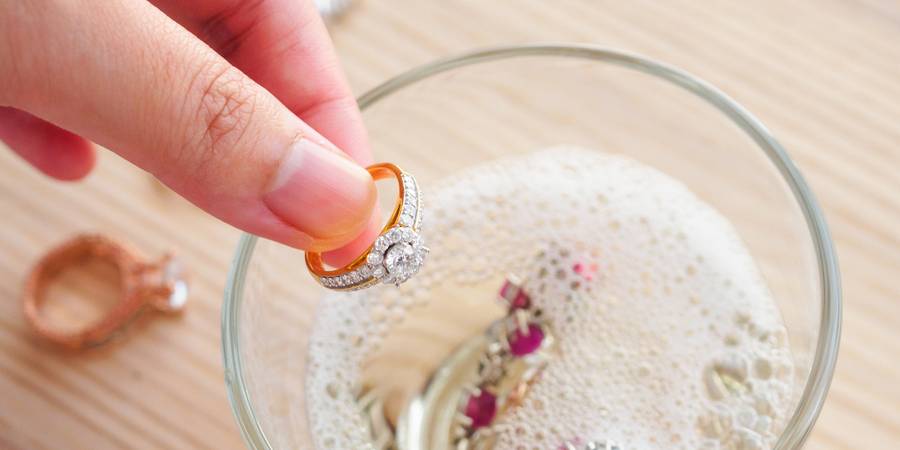
How to Clean a Channel Setting Jewelry
Channel settings provide enhanced security for your engagement ring, but they may require some extra care and cleaning due to their design.
To keep your channel-set ring in optimal condition, we recommend regular cleaning at home and an annual professional steam cleaning by your jeweler.
Here’s a simple method for cleaning your channel-set ring at home: Boil some water, remove it from heat, add a small amount of clear detergent, and let the ring soak for a while. Use a gentle toothbrush to dissolve any contaminants between the stones, brushing away residue carefully.
For everyday jewelry, it’s important to clean it multiple times a year to maintain its shine. If you only wear certain pieces occasionally, cleaning or dusting them a couple of times a year should suffice.
Additionally, have your jewelry professionally cleaned by a jeweler once or twice a year. Everyday jewelry, like your diamond wedding ring, requires more frequent cleaning.
Various factors, such as your skin’s natural oils, dust, cleaning agents, and water, can create a layer of tarnish on your ring, dulling its appearance. Even though diamonds are incredibly durable, a diamond ring should be polished with care.
Everyday cosmetics like hairspray, moisturizers, makeup, and perfume contain chemicals that can dull or leave residue on your jewelry, potentially causing damage. You can restore the sparkle of your jewelry by removing dust, debris, and grease yourself.
A simple and effective method involves soaking your diamond ring in a solution of lukewarm water and a small amount of ammonia for about twenty minutes. Gently polish the stone with a soft toothbrush, then rinse it under warm running water. Repeat if necessary.
Here are some chemicals you should avoid when cleaning your ring:
- Bleach, chlorine, or acetone: These strong household cleaning products can potentially damage the base metals in your diamond ring.
- Abrasive materials like toothpaste, baking powder, or powder-based cleaning solutions: These substances have the potential to scratch the precious metal, so it’s best to avoid using them for cleaning.
By following these cleaning guidelines and avoiding harmful chemicals, you can help maintain the beauty and shine of your channel-set ring.
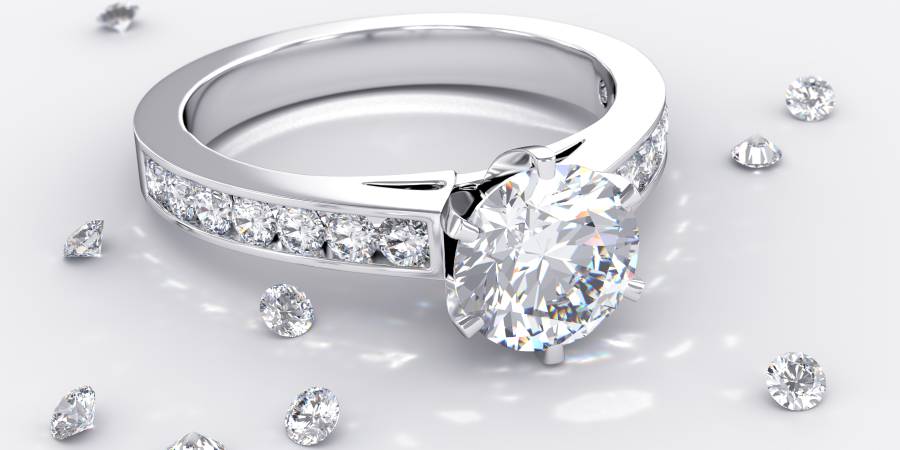
Can a Channel Set Ring Be Resized?
Resizing channel set rings can pose challenges due to the diamonds placed within the setting.
The resizing process for an engagement ring often involves cutting the shank and adjusting the metal. However, with a diamond-set channel setting, resizing may or may not be possible, depending on the specific design.
Resizing is typically not feasible for channel set engagement rings with diamonds covering the entire band, such as channel setting eternity rings. Altering the band’s diameter during resizing can compromise the secure placement of the diamonds.
Additionally, the channels within the setting may become twisted or misaligned during the resizing process, affecting the diamonds’ secure retention.
On the other hand, if you choose a channel setting with diamonds covering only half of the band (referred to as a “half-eternity” ring), you may have more flexibility for minor resizing adjustments.
Given the limited resizing options for channel set engagement rings, it’s important to know your fiancé’s ring size accurately before selecting this setting.
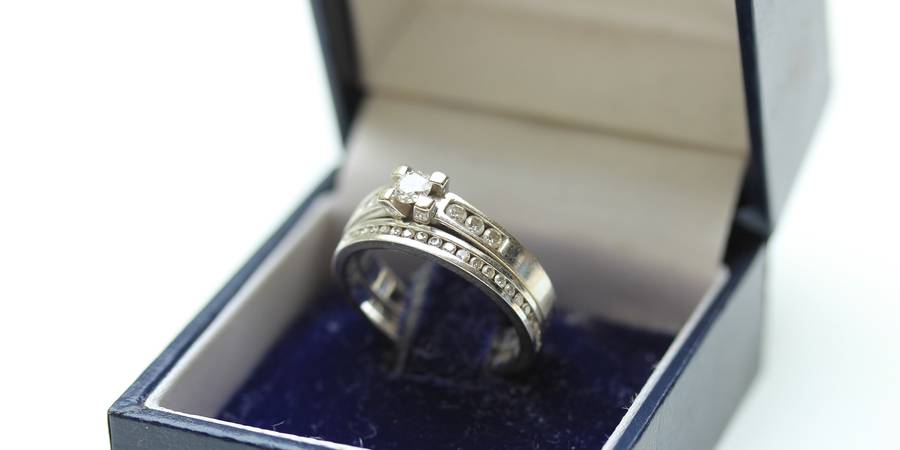
When Should You Avoid Wearing Channel Settings?
To ensure the longevity of your channel set ring, we advise against wearing it in certain situations where potential damage may occur.
- On the Beach:
Wearing jewelry on the beach is not recommended. The abrasive nature of sand can scratch the precious metal and potentially damage the diamonds and metal settings. If sand grains get trapped in the ring, it is advisable to seek professional assistance to thoroughly remove them.
- In the Sea:
It is best to remove your engagement ring or other jewelry before swimming in the ocean. Saltwater can erode the soldered components of channel setting rings, potentially leading to structural issues or fractures in extreme cases.
- In the Swimming Pool:
Before diving into a swimming pool, it is advisable to take off any jewelry, including channel set rings. Chlorine in pool water can corrode jewelry, making it susceptible to damage. It is recommended to keep your jewelry safe and dry in your hotel room or a secure location.
By avoiding these situations, you can help ensure the safety and longevity of your channel set ring.
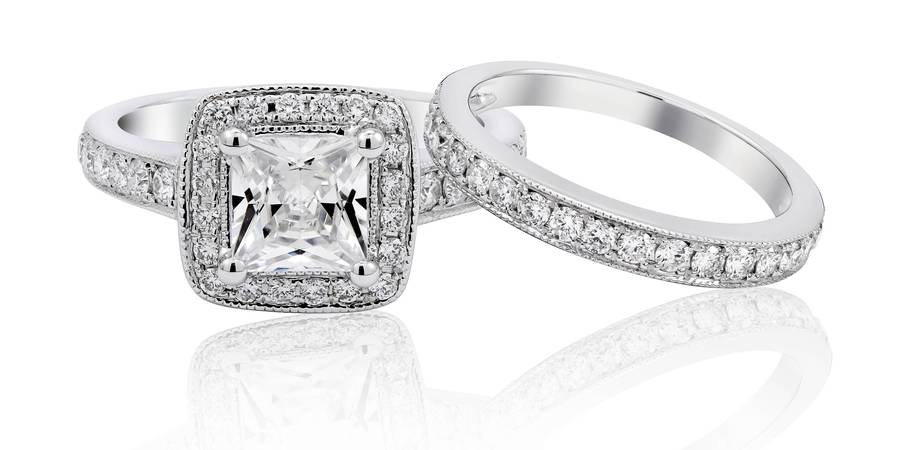
Why Choose a Channel Set Ring?
Channel set rings offer a distinctive and creative approach to the design of an engagement ring, along with several advantages that prioritize safety and security.
One notable advantage is that channel settings are both snag-free and highly secure. The design of the channel set ring ensures a secure placement of diamonds and gemstones without any protruding elements like prongs that could catch on clothing, hair, or furniture.
Furthermore, channel settings act as a protective barrier against bumps and impacts. When your engagement ring comes into contact with a door or a wall, the metal walls surrounding the diamonds absorb the force, providing significant protection against fractures, breaks, and loosening of the stones.
Another appealing aspect of channel set rings is their budget-friendly nature. They offer cost-effective options in multiple ways. Firstly, they are ideal for using less expensive diamonds, as the setting minimizes the visibility of any flaws while highlighting the smaller stones. Additionally, the process of setting multiple stones simultaneously saves time and cost.
Lastly, channel set rings are particularly suited for individuals with active lifestyles. The secure placement of diamonds and gemstones within the channel setting ensures their retention and protection even during vigorous activities. This makes channel set rings a practical choice for individuals with active daily routines or occupations that involve frequent use of their hands.
In summary, channel set rings offer both aesthetic appeal and practical benefits, making them an excellent choice for those seeking a secure, budget-friendly, and versatile engagement ring option.
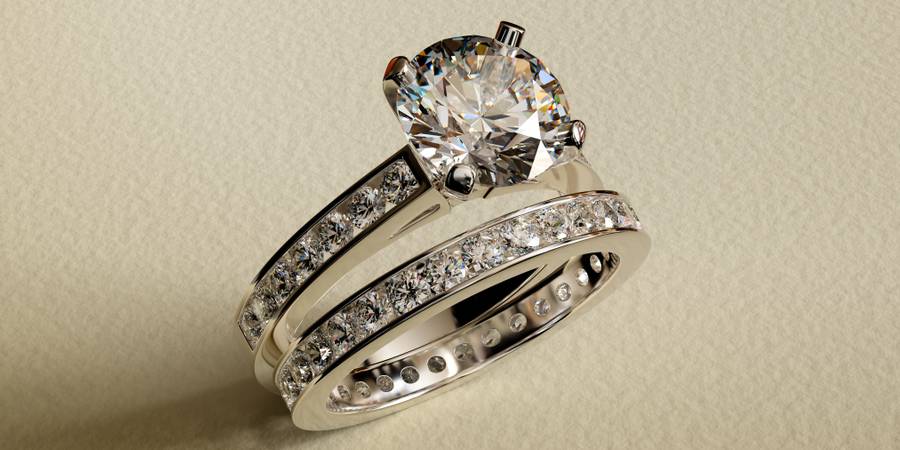
Channel Settings – FAQ (Frequently Asked Questions)
What Does a Channel Setting Entail in the World of Diamonds?
In the world of diamonds, a channel setting refers to a type of diamond ring band where smaller diamonds are placed within a “channel” created by two metal strips.
These diamonds are often set flush with the metal, providing an added level of protection.
This setting technique gives the impression of a continuous row of diamonds running along the band, contributing to the overall sparkle of the ring.
Is a Channel Setting Better Than a Prong Setting?
Both channel and prong settings are commonly used to showcase diamonds. Prong settings are often chosen when there is a center diamond as the main focus, but channel settings can be used with or without a central diamond.
If you want to maximize the beauty and brilliance of a high-quality diamond, a channel setting is an excellent choice. It allows the most light to enter and highlights the most valuable part of the ring.
Additionally, if you prefer smaller diamonds and desire a ring that exudes radiance, a channel setting is a great option. You can select the quantity and shape of the smaller stones, which will be securely set within the band.
However, you don’t have to choose between the two. You can combine a high-quality diamond set in prongs with a row of accents in a channel setting for a stunningly beautiful ring. This way, you can have brilliance at the top with the added sparkle from the diamonds in the channel.
Are There Any Similarities Between Channel and Prong Settings?
Although channel and prong settings exhibit noticeable differences, there are certain similarities between the two configurations. One shared characteristic is the ability to accommodate various diamond cuts.
Diamonds held in place by either channel or prongs can be round, princess, marquise, cushion cut, or other shapes. While round cuts are the most common for both settings, you have a range of options if you want to explore different shapes.
Another similarity is that a prong setting can incorporate a channel. You don’t have to choose exclusively between these two settings.
Opting for a prong setting with a high-quality diamond and a channel on the shank allows for a ring that enhances its brilliance. The small diamonds within the band will not detract from the top-quality diamond but rather enhance its overall sparkle.
How Can a Channel Setting Benefit You?
One of the greatest advantages of channel settings is the versatility they offer in terms of design.
A channel setting can be distinct from any other style of ring setting, allowing for unique and customized designs.
Jewelers can create channels in various shapes, such as straight lines, curves, or intricate swirls in white or yellow gold. Over the years, we have seen almost every imaginable style of channel set design.
While estate channel set rings are becoming more available, you may need to consider a bespoke engagement ring until the market catches up with demand.
However, this is not a drawback. You can browse through samples and choose a design that appeals to you. Your jeweler can then customize it to create a ring that is uniquely yours.
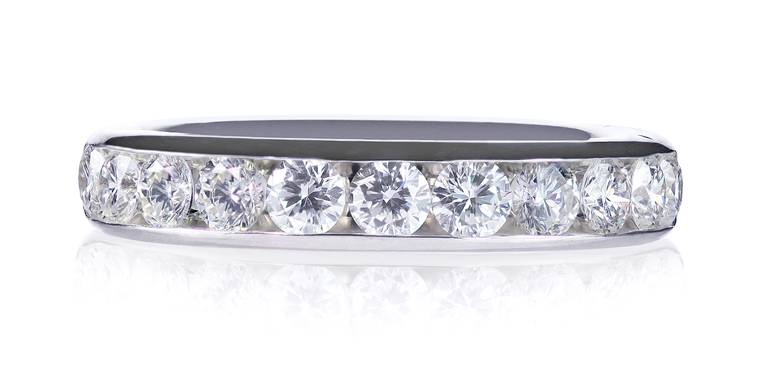
Final Thoughts
In conclusion, after exploring Channel Settings: Everything You Need to Know, it is clear that choosing a channel-set design offers numerous benefits. Whether you seek a timeless piece of jewelry or a style that enhances your overall look, channel settings are an excellent choice.
Throughout the article, we have provided comparisons with other settings, highlighted the advantages, addressed potential disadvantages, and covered various important aspects. Additionally, our FAQ section aimed to address any lingering questions or concerns you may have had.
We sincerely hope that this exploration of unique and beautiful ring settings has been informative and enjoyable. Thank you for joining us in delving into the world of channel settings!


